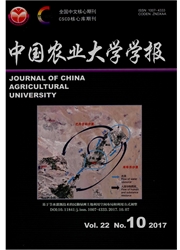

 中文摘要:
中文摘要:
研究目的:定量分析区域社会经济因素对耕地面积变化的影响,揭示中国区域耕地资源压力及其驱动因素的空间差异性特征。研究方法:利用STIRPAT模型和PLS方法拟合得到中国各省份耕地面积模型,依据变量投影重要性指数就各驱动因素对耕地面积影响的重要性程度进行分析,采用ArcGIS 9.2绘制耕地面积驱动因素影响的空间差异图。研究结果:各省份人口数量、产业结构、现代化对耕地面积的线性影响,有正效应或者负效应,且影响重要性程度差异明显。在以上述三因素为重要驱动因素的省(区、市)中,人口数量对耕地面积均起负效应,产业结构对北京、云南的耕地面积起正效应,现代化水平对上海、陕西起正效应,而对其他省(区、市)起负效应;富裕度对耕地面积的影响,有正效应或者负效应,有线性作用或者弹性作用,在以富裕度或其二次项为耕地面积重要驱动的9个省(区、市)中,富裕度或其二次项与耕地面积间存在2类类似环境EKC曲线关系,包括负效应趋于下降型(吉林)、正效应趋于增强型(山东、广西、山西、内蒙、河南、湖南、贵州、宁夏)。研究结论:通过分析,全面掌握中国28个省(区、市)耕地驱动因素及其空间分异状况,为后续耕地变化研究提供参考。
 英文摘要:
英文摘要:
The purpose of this paper is to quantitatively analyze the impact of regional social-economic driving factors on cultivated land change,and to reveal the press status of the regional cultivated land and the spatial variation of driving factors.STIRPAT model and PLS method were adopted.VIP value was used to analyze the importance extent of those four driving factors on cultivated land change.Based on the research results,figures of spatial map of the driving factors were drawn by ArcGIS 9.2.Results showed that population,industrial structure and level of modernization had positive or negative linear effects on cultivated land change.The effects of those three driving factors are spatial divergent.The variable of population showed negative effect in all provinces.The industrial structure only positively affects land area in Beijing and Yunnan.The level of modernization had positive effect in Shanghai and Shaanxi.The degree of economic development had positive or negative,linear or non-linear effects.In nine provinces,the quadratic term of the degree of economic development was the main driving factor.The relation between the quadratic term and cultivated land follows two kinds of EKC curves in empirical study.One is the kind of negative effect tending to go down(Jilin).The other is the kind of positive effect tending to be enhanced(Shandong,Guangxi,Shanxi,Mongolia,Henan,Hubei,Guizhou and Ningxia).The paper concludes that the status of spatial variation on the driving factors of cultivated land change in China can be measured,which can further serve as references for the follow-up studies on cultivated land change.
 同期刊论文项目
同期刊论文项目
 同项目期刊论文
同项目期刊论文
 Temporal and spatial variability of agricultural land loss in relation to policy and accessibility i
Temporal and spatial variability of agricultural land loss in relation to policy and accessibility i Impact of labor transfer on agricultural land use conversion at rural household level based on Logit
Impact of labor transfer on agricultural land use conversion at rural household level based on Logit Spatial autocorrelation analysis of Chinese inter-provincial industrial chemical oxygen demand disch
Spatial autocorrelation analysis of Chinese inter-provincial industrial chemical oxygen demand disch Evaluating the vulnerability of agricultural eco-economic system in a developed region: a case study
Evaluating the vulnerability of agricultural eco-economic system in a developed region: a case study 期刊信息
期刊信息
